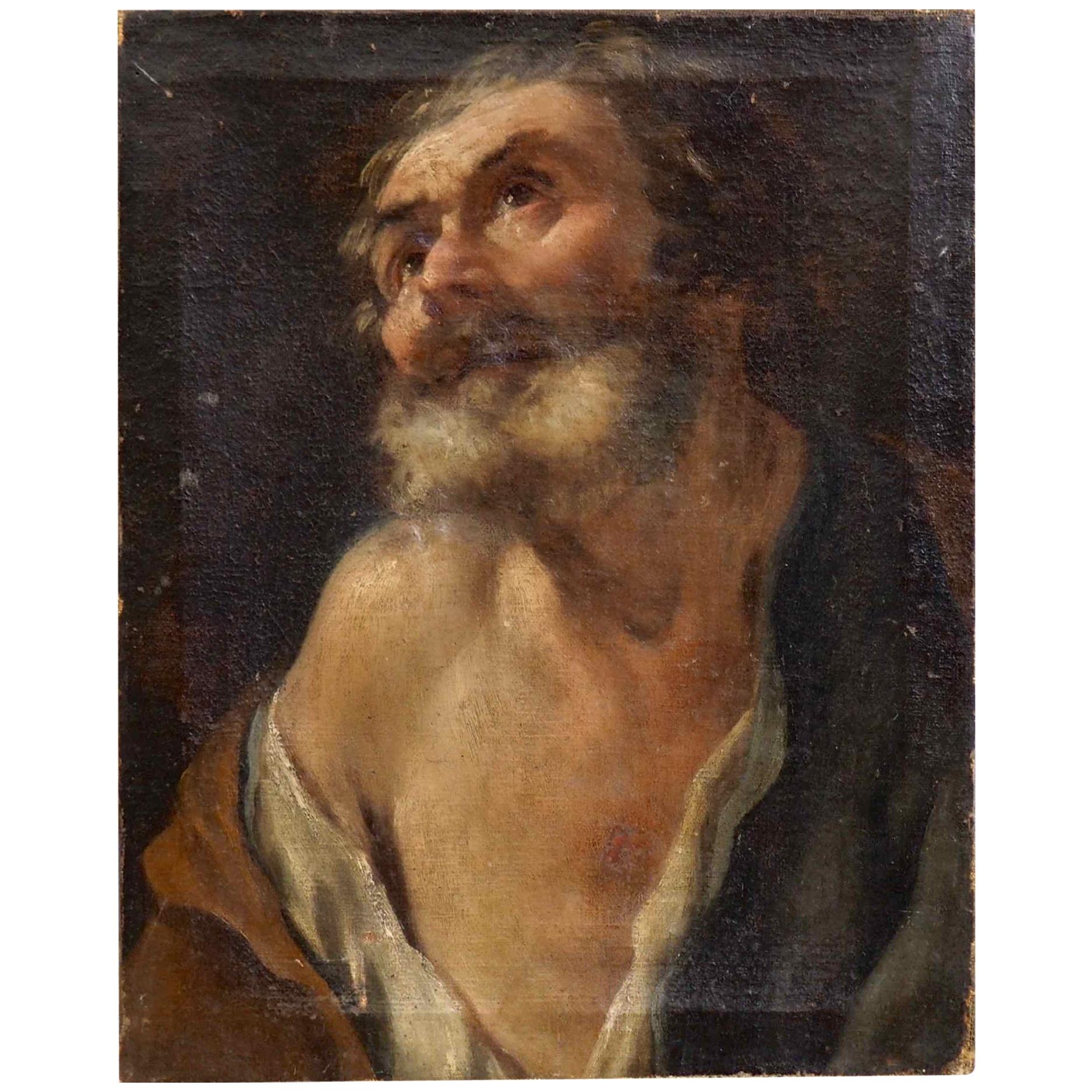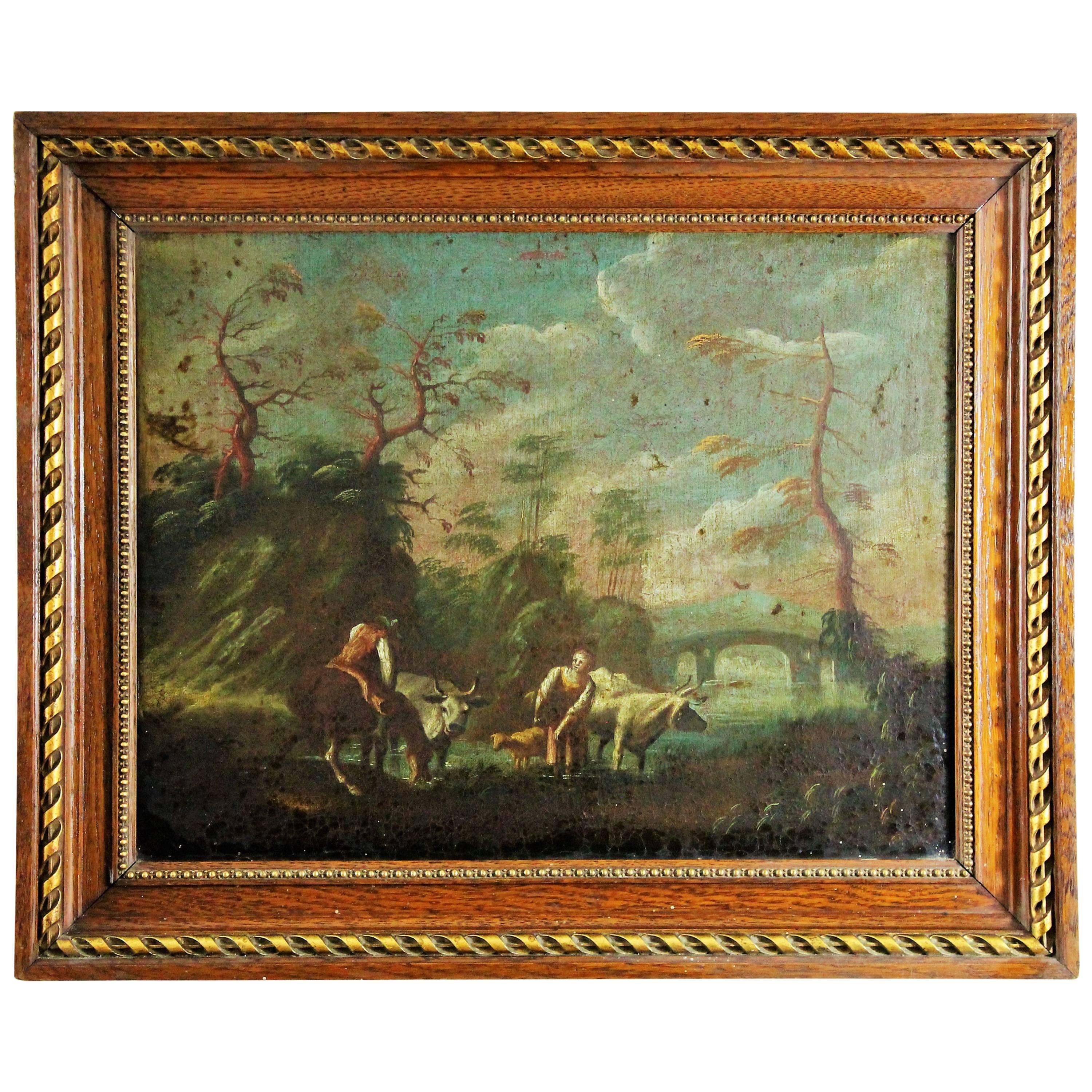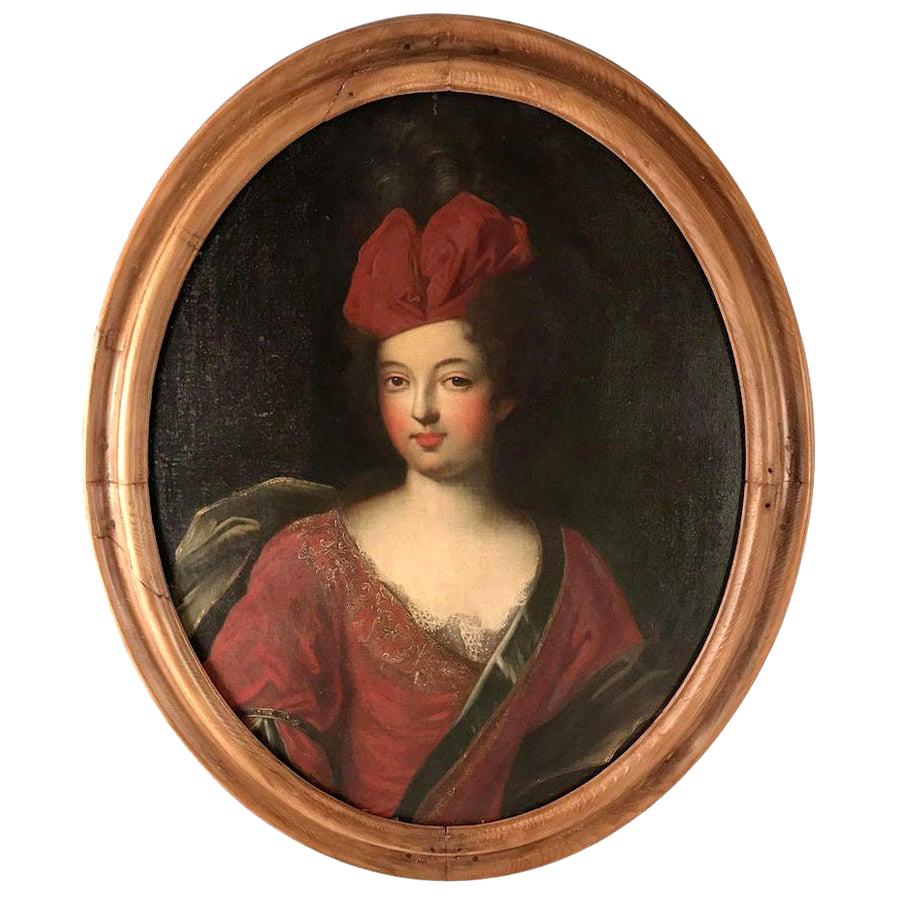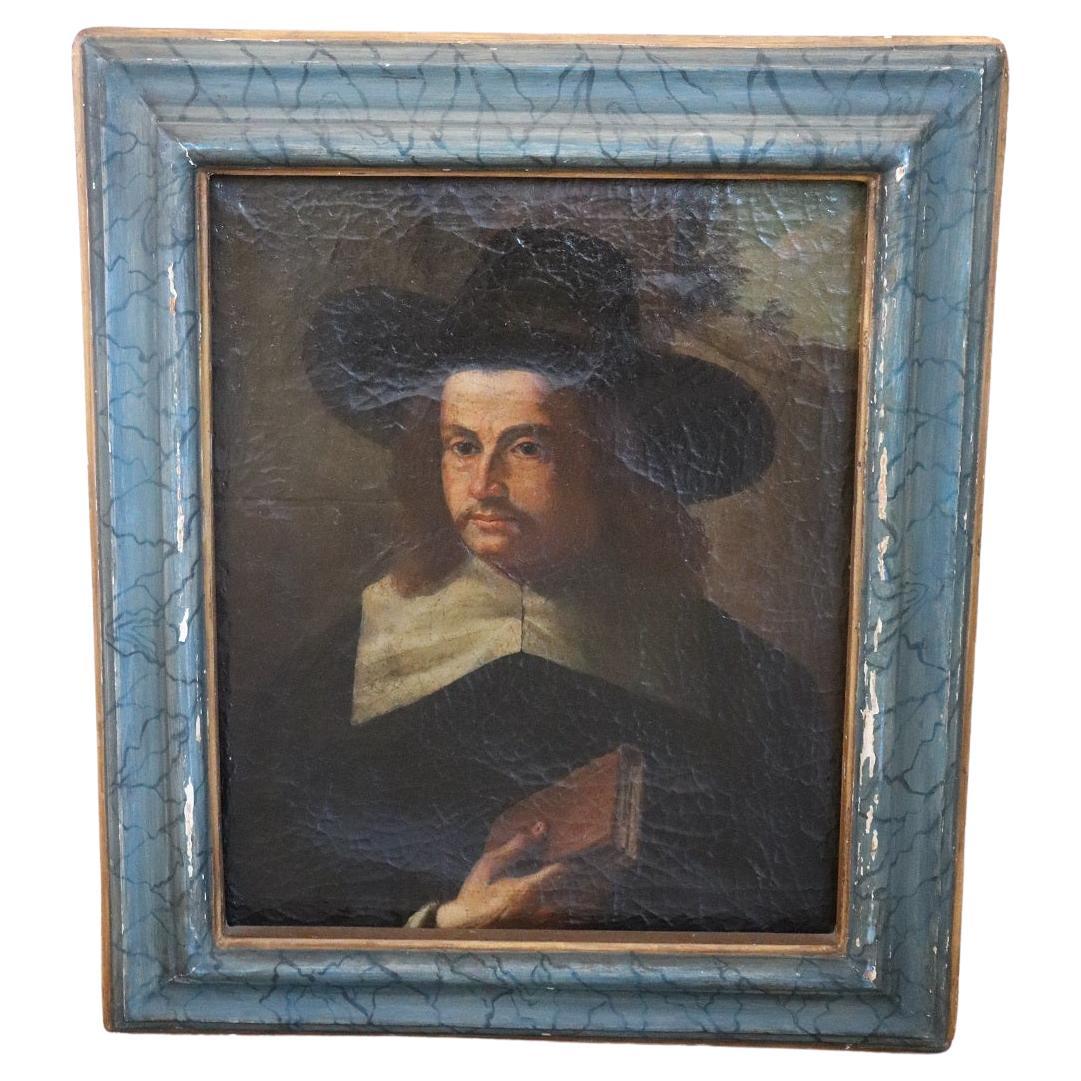Items Similar to 16th-17th Century Gentleman’s Portrait Oil on Canvas by Francesco Zucco
Want more images or videos?
Request additional images or videos from the seller
1 of 13
16th-17th Century Gentleman’s Portrait Oil on Canvas by Francesco Zucco
About the Item
Francesco Zucco (circa 1575-1627)
Gentleman’s portrait
Measures: Oil on canvas, cm 120 x 140
The painting analyzed here belongs to the pictorial production of Francesco Zucco, an artist from Bergamo trained in Cremona at the Campi school. Back in his native city, he met the paintings of the countrymen Moroni, Cavagna and Salmeggia. Zucco, as a local tradition, had in portraiture the most significant qualitative part of his production, identifying in the effigiati both individual characteristics and their social status. This work highlights precisely this double value: the intense gaze, fixed, transmits the soul of this squire of the time while, all the rest, characterizes its position. It is an official portrait, to pass on to posterity the appearance of the effigy. The hat with the medal and the feather, the ring on his finger, the hilt of the sword, the costume denote him as a noble man, perfectly aware of the fashion of the time. Here is an in-depth analysis of the dress: the ruffle with perforated lace, cuffs, gold embroidery, the geometric games of the decorations of the overcoat. To describe this realization ability we can here take up the words of Tassi written in 1793 about the portraitist Zucco, praising him as one of the most excellent painters of the city: "It was his custom to make them in a very diligent and finished manner, with thin veils, with milky collars, with chopped dresses, with battlements or embroideries adorned, with plumes, necklaces, handles, all conducted with great diligence to perfection conducted". The same red drape, profiled with a golden hem, and the columns on the left, underline the personality of the effigy. The opening on the landscape, resolved with quick brushstrokes, recalls the most daring innovations of sixteenth-century Venetian painting.
- Dimensions:Height: 55.12 in (140 cm)Width: 47.25 in (120 cm)Depth: 1.19 in (3 cm)
- Materials and Techniques:
- Period:Early 17th Century
- Date of Manufacture:16th-17th Century
- Condition:Refinished. Wear consistent with age and use. The painting has been cleaned.
- Seller Location:Milan, IT
- Reference Number:1stDibs: LU5918233438052

About the Seller
5.0
Vetted Seller
These experienced sellers undergo a comprehensive evaluation by our team of in-house experts.
Established in 2000
1stDibs seller since 2021
25 sales on 1stDibs
Typical response time: 10 hours
- ShippingRetrieving quote...Ships From: Milan, Italy
- Return PolicyA return for this item may be initiated within 14 days of delivery.
More From This SellerView All
- 17th Century Portrait of Saint Paul Painting Oil on Oval CanvasLocated in Milan, IT17th century Portrait of Saint Paul Measures: Oil on oval canvas, 67 x 50 cm - with frame 81 x 64 cm The portrait examined here depicts the Apostl...Category
Antique 17th Century Italian Paintings
MaterialsCanvas
- 17th Century Madonna with Child Painting Oil on Canvas Tuscan SchoolLocated in Milan, IT17th century, Tuscan school Madonna and Child Oil on canvas, 31 x 21 cm With frame, cm 37,5 x 27,5 The pearly incarnations and the thoughtful play of looks between the Virgin, turned to the Son, and Questi, warmly open to the viewer, pour out the present painting with compositional perfection. Virginal fabrics become mottled at the folds, wrapping the Madonna in a thin vitreous mantle. The pastel colors, shining on the pink robe just tightened at the waist by a gold cord, enliven the faces of the divine couple in correspondence of the cheeks, lit by an orange warmth. Even the left hand of the Virgin, composed in perfect classical pose (Botticelli, Madonna with Child, 1467, Musée du Petit Palais, Avignon), is sprinkled with warmth thanks to the immediate touch with Christ. From the nimbus of the Mother a delicate luminous disk is effused, which takes back, in the most distant rays, the colour of the hair of the Son, from the tones of the sun. The Child Jesus is represented intent in a tender gesture of invitation with the right hand, while with the other he offers a universal blessing: with his hand he retracts the index and annular palms, extending the remaining three fingers, symbol of Father, Son and Holy Spirit. The painting welcomes and re-elaborates that typically Tuscan formalism that boasted in the rest of Italy the constant appreciation by the most up-to-date artists and collectors. Arrangement, composition and mixing of colors place the canvas in the middle between the changing mannerist and the sculptural figures of Michelangelo, essential yardstick of comparison in terms of anatomical and expressionistic rendering. In the present, silvery and pinkish powders act as three-dimensional inducers to the Child’s mentioned musculature and to the vivid folds of the clothes, expertly deposited on the lunar whiteness of the skins. While these colours recall the equally brilliantly transparent colours of Pier Francesco Foschi...Category
Antique 17th Century Italian Paintings
MaterialsCanvas
- 17th Century Angelica and Medoro Painted Oil on Canvas Roman SchoolLocated in Milan, ITRoman School, 17th century Angelica and Medoro engrave their names on the bark of a tree Oil on canvas, 65 x 48.5 cm The canvas depicts one of the most famous episodes of O...Category
Antique 17th Century Italian Paintings
MaterialsCanvas
- 17th Century Christ and the Samaritan Oil on Canvas Roman SchoolLocated in Milan, ITRoman school of the 17th century Landscape with bridge - Christ and the Samaritan woman at the well Oil on canvas, cm 42 x 59,5 - With frame, cm 54, 5 x 71 cm The small canvas portrays a broad view of the city surrounded by a bucolic and lush landscape, probably a reinterpretation of the Roman countryside or the Agro. The fulcrum of the canvas is the bridge consisting of several bays beyond which stands a village. In the distance the landscape made of green mountains opens into what looks like a lake crossed by boats. The landscape is animated by the human presence; not only small and fleeting figurines intent on walking along earthy paths but also the representation, in the foreground, of an Gospel episode, that of Christ and the Samaritan woman at the well. The landscape can be clearly traced back to a painter trained on the examples of the great seventeenth-century Roman baroque landscape that sees in the Lunette Aldobrandini by Annibale Carracci but also in Claude Lorrain, Nicolas Poussin and Gaspar Doghet are its greatest achievers. If in the past, therefore, the landscape was considered the scenic background on which to project the representation of divine or human characters, in the seventeenth century it became an autonomous and codified pictorial genre. With Carracci comes the so-called ideal landscape: a mental reconstruction of a peaceful and harmonious nature in which the dream of a perfect communion with man is realized. In the wake of Hannibal, as mentioned, during the seventeenth century the "classic" Roman landscape knows a long and happy season by artists such as Domenichino, and the French Claude Lorrain, Nicolas Poussin and Gaspar Dughet. Lorrain investigates the Roman countryside in all its aspects, studying the variations in the different hours of the day, the seasons or weather conditions, but always nourished by a sense of bucolic Virgilian. With Poussin the approach becomes intellectual elaboration and sophisticated rational construction. From the examples of the great masters, the Roman Baroque season, from the middle of the century, saw the flourishing of several personalities who, with shots, but also important personal reworkings, led to further spread the genre. Among the personalities that can be compared to the work in question we cannot fail to mention Crescenzio Onofri (1634-1714), defined by Salerno as the only true pupil of Dughet, who then spread in Florence the taste of the Baroque landscape influencing Tuscan painters such as Panfi and Peruzzini. His paintings are in various Roman collections; such as, for example, the landscapes from the Sacchetti Collection and today at the Pinacoteca Capitolina. and those in the Almagià collection in Rome, others in the Palazzo di Montecitorio, but the most conspicuous group is in the Galleria Doria. In comparison we can mention the two passages of the National Gallery in London, the landscape with a bridge over the Antiquarian Market but also the design of the National Gallery of Art in Washington. In the work you can also find the influences of the art of Giovanni Francesco Grimaldi...Category
Antique 17th Century Italian Paintings
MaterialsCanvas
- 17th Century Saint Joseph Oil on Canvas Attributed to Antonio CifrondiLocated in Milan, ITAntonio Cifrondi (1665 - 1730), Attributed Man with stick - Saint Joseph Measures: Oil on canvas, Cm 115 x 79 - With frame, cm 139 x 103 This canvas is, for stylistic and c...Category
Antique 17th Century Paintings
MaterialsCanvas
- 17th Century Live Nature Pair of Paintings Oil on Canvas Flemish SchoolLocated in Milan, ITFlemish School, 17th century Live nature couple with animals Measures: Oil on canvas, cm 25 x 35 - With frame cm 37 x 48 The pair of canvases in question depicts two excited...Category
Antique 17th Century Paintings
MaterialsCanvas
You May Also Like
- Virgin of the Immaculate Conception, 16th Century, Oil on CanvasLocated in North Miami, FL16th Century Spanish Colonial Oil on canvas painting of the Virgin of the Immaculate Conception. In this representation of the Virgin Mary being f...Category
Antique 16th Century Spanish Spanish Colonial Paintings
MaterialsCanvas, Wood, Paint
- Late 17th Century Oil Portrait of a LadyLocated in Lymington, GBAn oil on canvas portrait of a young French courtier, circa 1690. This evocative antique French school picture has been attributed to the portrait painter Jean-François de Troy (1679-1752). De Troy was famous as a portrait painter of fashionable society women. This is a very attractive late 17th century painting surviving in its original frame and stretcher. The canvas appears to be untouched. References: 'Jean François de Troy, The Alarm, or the Gouvernante Fidèle', at the Victoria and Albert Museum, London. 'Jean François de Troy, Paris 1679 - Rome 1752', at the Thyssen-Bornemisza Museum. Laurie G. Winters, Troy, de, Grove Art Online, Oxford Art Online, Oxford University Press, 6 May 2016. Everett Fahy & Jayne Wrightsman...Category
Antique 17th Century French Paintings
MaterialsCanvas
- Oil on Canvas Paint Flemish School, 17th Century BelgiumLocated in Beuzevillette, FROil on canvas depicting a country scene: a man watering his horse near a river where two cows and a sheep wade accompanied by a farmer. Work of northern France or Belgium of the 17t...Category
Antique 17th Century Belgian Paintings
MaterialsCanvas
- Italian Old Master Painting, 17th Century, Oil on CanvasLocated in Aalsgaarde, DKItalian old master painting, 17th century, oil on canvas. Good condition Measures: H. 54 W. 43 cm H. 21.2 W. 16.9 in.Category
Antique 17th Century Italian Paintings
MaterialsPaint
- 17th Century Italian Antique Oil Painting on Canvas Portrait of a GentlemanLocated in Casale Monferrato, ITBeautiful antique oil painting on canvas portrait of a gentleman with book.. Excellent pictorial quality great attention to detail. Flemish school school of the 17th century. Not signed. Sold with rare 17th century antique wooden frame...Category
Antique 1660s Dutch Paintings
MaterialsCanvas
- 17th Century Antique Oil Painting on Canvas Portrait of a Gentleman with FurLocated in Casale Monferrato, ITBeautiful antique oil painting on canvas portrait of a gentleman with fur. Excellent pictorial quality great attention to detail. Flemis...Category
Antique 1660s Dutch Paintings
MaterialsCanvas





